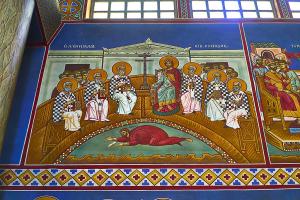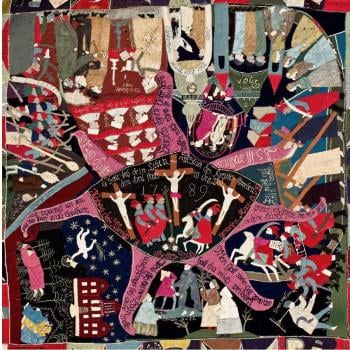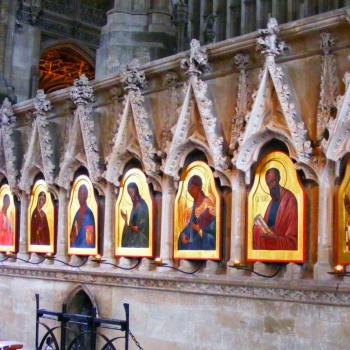
God is great. The record of salvation history found within Holy Scripture provides us many examples of that greatness. It shows us people who have had encounters with God which changed them for the better. We read, for example, of the relationship between God and Abraham: Abraham, out of great faith, followed God without knowing his destination. Because of his fidelity, God was with Abraham, helping him in his time of need, such as when Abraham went to rescue Lot. We learn also how God blessed Abraham in his encounter with Melchizedek, the priest-king of Salem: “And Melchizedek king of Salem brought out bread and wine; he was priest of God Most High. And he blessed him and said, ‘Blessed be Abram by God Most High, maker of heaven and earth; and blessed be God Most High, who has delivered your enemies into your hand!’ And Abram gave him a tenth of everything” (Gen. 14:17-20 RSV). We know God was with the Israelites, acting in and through Moses, doing wonderful things for them, things which helped the people of Israel overcome their oppressors, things which served as terrors to those who harmed the people of Israel: “He is your praise; he is your God, who has done for you these great and terrible things which your eyes have seen” (Deut. 10:21 RSV). Abraham understood the need for hospitality, and Moses explained that need in relation to the experiences of the people of Israel: “Love the sojourner therefore; for you were sojourners in the land of Egypt” (Deut. 10:19 RSV). We are to remember them and their experiences; we are to keep in mind the lessons they learned, even as we can and should depict them, both in word, but also in other media, such as holy images (icons) or statues. If we can imagine them with our minds, using words, we already find ourselves using images to represent them. And if there is any doubt, we can look to the incarnation, where we find the Word of God has a human image, showing God took on and uses images for our sake. The Word reveals to us the truth of God, and in doing so, uses human conventions and expressions, human images, up to and including taking up and showing us a human image which we can see and touch. This is why we can use images of all kinds, including visual images, to reveal the truth of history and of God – but only if we understand what those images mean and represent, and do not abuse them and turn them into idols which constrict our understanding of the truth.
This is why it was important for Christians to recognize the difference between idolatry, the various way idolatry can be engaged, and authentic Christian use of images. Idolatry is to be rejected, but not all use of images represents idolatry. The problem with idolatry is that it limits the truth, it reveals an incomplete and therefore imperfect representation of the truth and tries to tie the truth down to that partial view, leading to all kinds of error insofar as the greater truth is denied. With the loss of the greater, holistic truth, all kinds of bad actions are promoted, causing harm to the people and society who do them. But, if images are being used properly, then, as II Nicea affirmed, God can be imagined, be it with words, paintings, or statues. God is a great artist, and as an artist, gave images to all things which are created; this alone should prove to us the creation of images which is the problem. All images come from and reveal the Logos of God, as all of them are logoi in the Logos, which is why the primary and authoritative image is found in the Word (Logos) made flesh: “He is the image of the invisible God, the first-born of all creation” (Col. 1:15 RSV). In and through him, we have the way to the Father, the way to experience the Father, even with our senses. “I have manifested thy name to the men whom thou gavest me out of the world; thine they were, and thou gavest them to me, and they have kept thy word” (Jn. 17:6 RSV). We are called to apprehend the truth revealed in such images without thinking such apprehension leads to comprehension of the truth – once we assume comprehension, we turn from the proper use of images to idolatry. This is because all such images, in their own way, can serve as symbols which both hold what is symbolized in them, but also point beyond the appearances, that is to the greater truth which we are called to seek after and follow. Therefore, we have the Word of God showing us that we can and should use images, and if we do so, we can do so to represent the truths of God, including the truths revealed in salvation history, but also the truths in the way God has worked with others and made them holy (which is why, for example, saints can be depicted in them).
Idolatry is wrong, but we must not confuse idolatry merely with the creation of and use of images. If it were, then God would not have told the people of Israel to use some images, such as those on the ark of the covenant, or those in the Temple. God restricted their use, and the point of that restriction was to make sure images were not misconstrued, that they were not turned into something they were not. The people of Israel were constantly reminded of the transcendence of God. With the incarnation, with the Word of God made flesh, some of the restrictions were lifted, because images can serve to represent another aspect of divine reality, the presence of the kingdom of God all around us, and with it, the immanence of the eschaton in the incarnation. Christians could and should put to word and to various visual media the truths of the incarnation, realizing that they find themselves connecting to the truths being depicted through them, even as, in the Passover, the people of Israel connected to the truths revealed in and through Moses. The Council of Nicea II gave an authoritative stamp to this truth, pointing out that in and through the incarnation, what was not prudent has become prudent, that times change and with them, our disciplines can and must change. But we must always keep in mind the warnings against idolatry so we do not end up using images in vain.
Stay in touch! Like A Little Bit of Nothing on Facebook.
If you liked what you read, please consider sharing it with your friends and family!
N.B.: While I read comments to moderate them, I rarely respond to them. If I don’t respond to your comment directly, don’t assume I am unthankful for it. I appreciate it. But I want readers to feel free to ask questions, and hopefully, dialogue with each other. I have shared what I wanted to say, though some responses will get a brief reply by me, or, if I find it interesting and something I can engage fully, as the foundation for another post. I have had many posts inspired or improved upon thanks to my readers.












